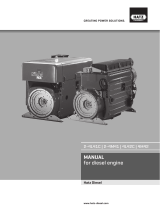
4 5000217755IVZ.fm
1 CALIFORNIA Proposition 65 Warning .....................................................................3
2 Preface .......................................................................................................................6
3 Introduction ...............................................................................................................7
3.1 Means of representation for this operator's manual....................................................... 7
3.2 Wacker Neuson representative...................................................................................... 7
3.3 Described machine types............................................................................................... 7
3.4 Identification of the machine .......................................................................................... 8
4 Safety .........................................................................................................................9
4.1 Principle ......................................................................................................................... 9
4.2 Qualification of the operating personnel ...................................................................... 11
4.3 Protective gear............................................................................................................. 11
4.4 Transport...................................................................................................................... 12
4.5 Operating safety........................................................................................................... 13
4.6 Safety during the operation of vibratory plates ............................................................ 14
4.7 Safety during the operation of combustion engines..................................................... 15
4.8 Safety during the operation of hydraulic machines ...................................................... 16
4.9 Maintenance ................................................................................................................ 16
5 Safety and information labels ................................................................................18
6 Scope of delivery ....................................................................................................20
7 Structure and function ............................................................................................21
7.1 Application ................................................................................................................... 21
7.2 Functional description .................................................................................................. 21
8 Components and operator's controls ...................................................................22
9 Transport .................................................................................................................23
9.1 Transporting the machine ............................................................................................ 24
10 Use and operation ...................................................................................................25
10.1 Prior to starting the machine ........................................................................................ 25
10.1.1 Checks before startup..................................................................................... 25
10.2 Starting up.................................................................................................................... 25
10.2.1 Starting the engine with recoil starter.............................................................. 25
10.2.2 Starting the engine with electronic starter....................................................... 26
10.3 Operating the machine................................................................................................. 26
10.3.1 Operating in the forward and reverse direction............................................... 26
10.3.2 Compacting on a slope ................................................................................... 26
10.4 Decomissioning............................................................................................................ 27
11 Maintenance ............................................................................................................28
11.1 Maintenance schedule ................................................................................................. 29
11.1.1 One-time maintenance after initial operation .................................................. 29
11.1.2 Daily maintenance work.................................................................................. 29
11.1.3 Regular maintenance...................................................................................... 30
11.2 Maintenance work........................................................................................................ 31
11.2.1 Cleaning machine ........................................................................................... 31
11.2.2 Cleaning the air cleaner .................................................................................. 31
Inhalt





























